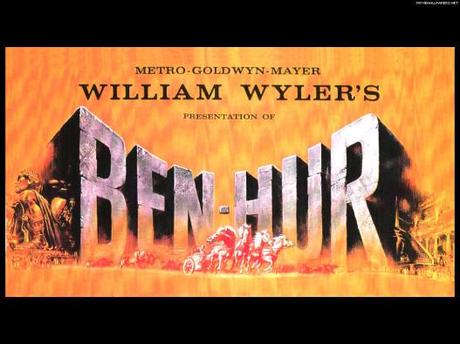 Poster art for William Wyler’s Ben-Hur (1959)
Poster art for William Wyler’s Ben-Hur (1959)With the coming of the fall season and the expectation of cooler and balmier days ahead, now would be an appropriate time as any to introduce a new series of posts — an artistic reawakening for yours truly: in this instance, an overview of some of my favorite scenes from movies past and present.
I’ll call this series “The View from the Chair.” Whose chair? That all depends! Admittedly, it would be a picture-perfect excuse to shape our discussion around a particular director’s point of view, or that of an actor or group of actors; thus metaphorically killing two birds with one stone. By whatever means this topic can be approached, it would be great fun to simply get those cameras rolling — the motive be damned!
So, without further ado, let’s jump-start this series with an analysis of two scenes from one of the all-time most watchable family features: the 1959 widescreen, Technicolor remake of Ben-Hur.
At the time of the film’s release, this multi-award-winning epic cost Metro-Goldwyn-Mayer a hefty $12.5 million, an immense sum even in those bygone times. Over 15,000 sketches were drawn prior to building the three hundred or more life-size sets on which the story would take place. These sets covered approximately 150 acres of territory in and around Cinecittà Studios in Rome.
None of these figures remotely begins to take into account the sheer number of extras involved in the project, to include technical and administrative staff, work crews, painters, architects, camels, horses, props, costumes, food and drink, to say nothing of the tons of materials necessary in recreating the massive arena where the famous chariot race would be run. Months of preliminary planning and backbreaking labor went into this effort prior to the first feet of film being shot.
With impressive location footage and a sturdy international cast, headed by Charlton Heston as Ben-Hur, Stephen Boyd as Messala, Jack Hawkins as Quintus Arrius, Hugh Griffith as Sheik Ilderim, Finlay Currie as Balthazar, Martha Scott as Miriam, Cathy O’Donnell as Tirzah, Sam Jaffe as Simonides, and Haya Harareet as his daughter Esther, the picture went on to gross over $40 million at the box office, not to mention its record-setting eleven Academy Awards for Best Picture, Best Cinematography (Robert L. Surtees), Best Actor (Heston), Best Supporting Actor (Griffith),and Best Score (Miklós Rózsa).
One of those coveted honors went to director-producer William Wyler. A German-born immigrant to the U.S., Wyler studied music at Lausanne and Paris. His film career took off in 1922 at Universal Pictures’ New York headquarters, first as a messenger boy and then as a publicity writer. Moving to the West Coast, Wyler apprenticed as a prop man, grip, script clerk and cutter, rising in rank to become a casting director, then an assistant director on several pictures, among them The Hunchback of Notre Dame starring Lon Chaney (1923) and the silent version of Ben-Hur (1925) with Ramon Novarro and Francis X. Bushman.
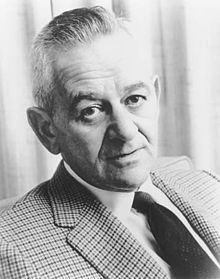
A list of Wyler’s accomplishments must surely encompass such classics as Dodsworth (1936) with Walter Huston, Jezebel (1938) with Bette Davis, Wuthering Heights (1939) with Merle Oberon and Laurence Olivier, The Letter (1940) with Davis and Herbert Marshall, The Westerner (1940) with Gary Cooper, The Little Foxes (1941) with Davis with Marshall, Mrs. Miniver (1942) with Greer Garson, The Best Years of Our Lives (1946) with Fredric March, The Heiress (1949) with Olivia de Havilland, Roman Holiday (1953) with Audrey Hepburn, The Desperate Hours (1953) with March and Humphrey Bogart, Friendly Persuasion (1956) with Cooper and Dorothy McGuire, and The Big Country (1958) with Gregory Peck, Jean Simmons, and Charlton Heston in a supporting role.
That’s quite an impressive résumé by any standard. Still, the director had a reputation as a demanding taskmaster who often clashed with cast and crew. Known in the business as “90-Take Willie” for his copious retakes and excessively fastidious working habits, Wyler’s background in the cinema on a multitude of assignments, and his ability to get the best performances possible out of his stars, prepared him well for the rigors of helming Ben- Hur, one of Hollywood’s finest (and longest) Biblical spectaculars.
Ralph Winters, the Oscar-winning film editor on Ben-Hur, described him as “a damn good director, Wyler was. Damn good. But I didn’t care too much for him personally.”
Keeping all of the above in mind, let’s take our assigned seat in the reserved section and turn to the epic at hand.
Begin at the Beginning
“Then God said: ‘Let us make man in our image, after our likeness.’”– Genesis 1:26
“The Lord God formed man out of the clay of the ground and blew into his nostrils the breath of life, and so man became a living being.” – Genesis 2:7
The act of creation, so movingly depicted in the first book of the Bible through these two powerful yet poetically-inspired passages, also frames the opening and closing credits of our feature film.
Notwithstanding the above, the movie proper begins with a brief prologue showing the birth of Christ — the New Adam, born without sin to Mary and Joseph, hitherto known as the Holy Family — in the picaresque town of Bethlehem. Three Wise Men from the East have come to pay homage to the child Jesus, who lies comfortably in a stable while cradled in his mother’s arms.
This gentle episode, whereby family unity and stability are stressed — a unity and stability that will soon be shattered by unfolding events — is immediately followed by a majestic brass fanfare (the score comes courtesy of veteran composer Rózsa) announcing the main title sequence. As the credits roll, in the background and completely filling the widescreen space is a detail of Renaissance artist Michelangelo’s brilliant rendering of the “Creation of Adam” panel from the Sistine Chapel in Rome.
In H.W. Janson’s classic work, The History of Art: A Survey of the Major Visual Arts from the Dawn of History to the Present Day, the scholar offers the following commentary concerning Michelangelo’s monumental conception: “[The panel] shows not the physical molding of Adam’s body but the passage of the Divine spark — the soul — and thus achieves a dramatic juxtaposition of Man and God unrivaled by any other artist… the dynamism of Michelangelo’s design contrasts the earth-bound Adam and the figure of God rushing through the sky.”
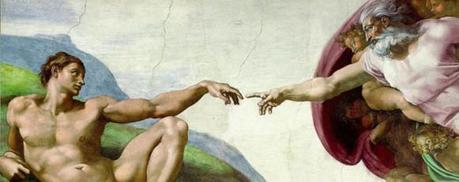
It’s a captivating combination: on one side we have God (the Old Testament, gray-bearded father figure), caught in the very act of creating, with Man (His earthly offspring) receiving the “breath of life” from the creator. God appears to be admiring His creation, faintly nodding to him in pride and approbation; while on the other side, Man — fragile, alone, helpless, and adopting a childlike expression of awe and reverence — looks to God with hope and longing, little realizing that permanent expulsion from the Maker’s Paradise is just around the corner.
If we look further into this stately introduction, we make note of the fact that our title character, Judah Ben-Hur, will himself be expelled from his own paradise — that is, his family’s ancestral estate. But of course, we do not know this going into the drama. We will learn about his fate soon enough.
Although the full title of Wyler’s epic, Ben-Hur: A Tale of the Christ, refers to a subplot that hardly seems fitting for the main course of action, the film turns often to the recurring Christ figure, who has His own musical motif from the start — followed swiftly by the four-note Ben-Hur theme, placed in direct succession to that of Christ’s in order to capitalize on the religious, political and ideological distinctions between the true protagonists of the drama: Judah and Messala.
Judah Ben-Hur, a prince of the Jewish people — a man at the height of his wealth and power, who, like Adam, experiences a fall from grace, only to regain a semblance of his former stature by film’s end; and Messala, his boyhood companion, now a hardened Roman tribune hell bent on bringing order to the unruly province of Judea, thus furthering his own deep-seated career ambitions at the expense of his former friendship with Judah.
Their past association — or what little of it that remains — is severely tested when Judah, refusing to aid Messala’s cause by revealing the names of the Jewish resistance leaders, is wrongly accused of threatening the life of the new Roman governor. As penalty for his “crime,” Messala sends him off to hard labor on board a Roman warship, while his mother and sister are held as prisoners in the fortress’ dungeon. Condemned to a living death, Judah will spend the rest of his days chained to an oar.
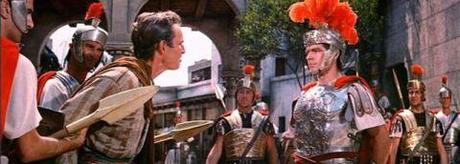
What Judah subsequently suffers through — his grueling ordeal in the galley, his rescue of Roman consul Quintus Arrius, his freedom from bondage and eventual redemption and reclamation of his family’s rights — is mirrored in a parallel story involving Christ’s suffering and Passion.
This setup happens to be bookended by two scenes that call to mind the opening “Creation of Adam” sequence. Throughout the story, various acts of kindness — represented by touching, giving and receiving — are reenacted by the film’s participants for the audience’s benefit as well as their own. Wyler references these acts at key moments so as to alert us to their deeper meaning within the context and framework of the plot.
A Series of Unfortunate Events
In the first scene under review, Judah is marched through the parched desert country as punishment for his alleged attack. Accompanying him are Roman guards and other criminals. They are on their way to the port of Tyrus to serve out their harsh sentence. It’s blisteringly hot and dusty. Exhausted from the long trek through the sand and rock, one of the prisoners falls to the ground. Rather than minister to a condemned man, the guards untie his bonds and toss the body over the dunes to its death.
The music in this sequence, both angular and sharp, is disconcerting in its dissonance. Calling to mind a similar set of circumstances from twenty years prior, it will remind attentive viewers of Rózsa’s powerful score for Zoltan and Alexander Korda’s desert saga, The Four Feathers from 1939.
Finally, the prisoners arrive at a village, where they pass the house of a certain carpenter, sawing away at his workbench. The line of prisoners moves from left to right. The soldiers call for a temporary respite from the march. “Water for the soldiers!” one of the guards shouts. “Soldiers first!” Some of the prisoners leave their formation and rush to the well, but they are beaten back into line, where they await the hapless villagers who are forced to attend to their needs.
As each prisoner is handed a cup or a bowl, Judah waits his turn with hands outstretched. Again, the camera pans from left to right, surveying the ragged line of desperate men. The first to drink is a soldier on horseback, who takes a huge swig from a ladle. Just as another ladle reaches Judah’s lips, a pug-nosed foot soldier snatches the water from his hands and barks out an order: “No water for him!”
After quenching his thirst, the pug-nosed soldier arrogantly spits out the remainder. Judah attempts to gather what droplets he can salvage, but the soldier roughly pushes him back into line. Denied the water’s life-giving sustenance, Judah collapses to the ground in despair.
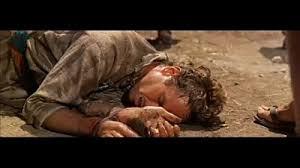
Helpless, alone, and at the end of his rope, he cries out to in a choked voice, “God, help me.” He has been beaten into the ground from whence he came, and from whence God made Man. “For dust you are, and unto dust shall you return” is the Biblical passage most closely related to the foregoing.
Judah’s body occupies the left and middle portions of the frame. His arms are extended (especially his left arm) in the same manner as that of Adam in the “Creation of Adam” panel at the start. Just then, a shadow crosses Judah’s face and form. We hear the soft theme music associated with Christ — ironically, the same theme music the trumpets and full orchestra had thundered forth during the opening credits.
Wyler had his award-winning cinematographer Robert L. Surtees shoot this crucial scene with his camera low to the ground, forcing the viewer down to the characters’ eye-level for a closer and more intimate encounter.
Christ approaches Judah with ladle in hand and sprinkles water over his neck, head and face. Next, He touches Judah’s left hand with His right in replication of God’s bringing Adam to life. Seemingly “baptized” in water and earth, Judah’s head is lifted up from the ground and onto the ladle and its thirst-quenching contents. Judah drinks his fill of the water while Christ gently strokes his hair and forehead — a much-needed sign of comfort and affection where previously none existed.
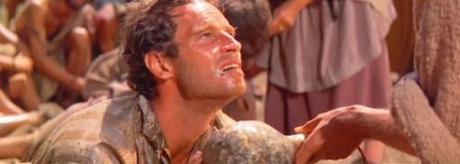
Judah stops to look up with hope and longing (just as Adam did to God) at the man who favored him with libation. He then resumes the business of drinking. At that very moment, the pug-nosed soldier catches sight of Christ with Judah and calls out, “You! I said no water for him!”
The soldier pulls out his whip and is ready to give the miscreant a thorough lashing, when abruptly Christ rises to his feet (occupying frame right), the low camera angle giving Him the impression of towering over the guard. Backing off, the soldier looks down at the ground, then at Christ, then at the others to his right, and at the ground again before finally turning away. He takes one last look at Jesus and barks another command, “All right, on your feet, all of you!” before sauntering off.
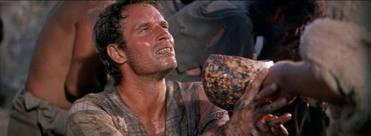
Thoroughly sated, the reinvigorated Judah returns the ladle to Christ. In a gesture of gratitude, Judah reaches out to touch His hand. They both rise simultaneously to their feet, with Judah occupying the center of the frame and Christ opposite him and to the side. The camera closes in on Judah, who is now in the exact center — reclaiming, as it were, his rightful spot as the focus of attention. A mounted guard comes over to lash him with a whip, shouting: “You there, back to your place! Back to your place!”
Getting back in line with the prisoners who resume their lengthy walk to the port, Judah (the Ben-Hur theme resounding nobly in the orchestra) cannot help but look back at the man who saved his life — the one who has given him a second chance and renewed his faith in the goodness of men.
As the sequence comes to a close, Christ, with his back to the audience (His face is never seen from the front), moves to the extreme right of the film frame, the ladle still dangling from his left hand — his gaze deliberately directed at Judah. They will meet again before film’s end. Meanwhile, Judah and the line of prisoners are at left, walking slowly away in the distance.
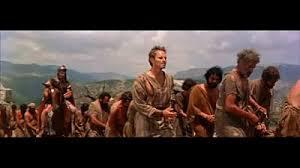
The camera shifts its focus to Judah’s face, which again happens to be in the middle of the frame. He stops briefly to give pause to what has occurred. With his chin up and head held high, Judah takes one last look behind him (much as the pug-nosed soldier had moments before), at the place and person he left behind. They will be etched in his memory for later. Once again, he joins the other prisoners on their walk of life, little realizing where the road will take him next.
End of Scene One
(To be continued…)
Copyright © 2014 by Josmar F. Lopes

